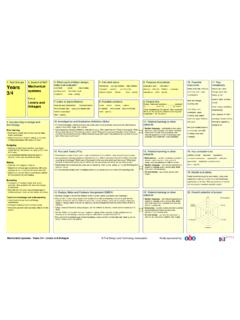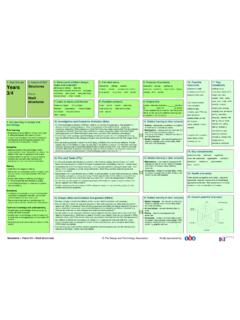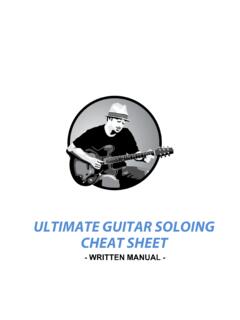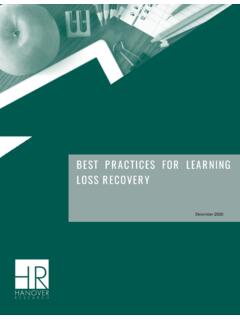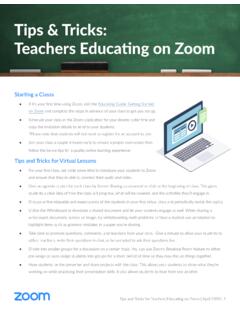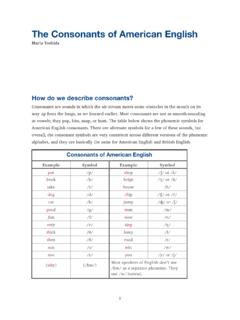Transcription of 4. What could children design, 17. Key Years Mechanisms
1 Mechanisms Years 1/2 Sliders and Levers The Design and Technology Association Kindly sponsored by: 1. Year Groups Years 1/2 3. Key learning in design and technology Prior learning Early experiences of working with paper and card to make simple flaps and hinges. Experience of simple cutting, shaping and joining skills using scissors, glue, paper fasteners and masking tape. Designing Generate ideas based on simple design criteria and their own experiences, explaining what they could make. Develop, model and communicate their ideas through drawings and mock-ups with card and paper. Making Plan by suggesting what to do next.
2 Select and use tools, explaining their choices, to cut, shape and join paper and card. Use simple finishing techniques suitable for the product they are creating. Evaluating Explore a range of existing books and everyday products that use simple sliders and levers. Evaluate their product by discussing how well it works in relation to the purpose and the user and whether it meets design criteria. Technical knowledge and understanding Explore and use sliders and levers. Understand that different Mechanisms produce different types of movement. Know and use technical vocabulary relevant to the project. 2. Aspect of D&T Mechanisms Focus Sliders and Levers 10.
3 Investigative and Evaluative Activities (IEAs) children explore and evaluate a collection of books and everyday products that have moving parts, including those with levers and sliders. What is it? Who is it for? What is it for? Use questions to develop children s understanding What do you think will move? How will you make it move? What part of the product moved and how did it move? How do you think the mechanism works? What else could move in the product? How well does it work? Introduce and develop vocabulary lever, pivot, slider, left, right, push, pull, up, down, forwards, backwards, in, out. 12. Focused Tasks (FTs) Demonstrate simple levers and sliders to the children using prepared teaching aids.
4 It is helpful if these are also used in context the slider is used to show a snail appearing from behind a stone, the lever is used to show a butterfly flying to a flower. Use questions to develop children s understanding How does the slider move? How does the lever move? Which part of the mechanism is the pivot? What does the movement of the slider and lever remind you of? Following teacher demonstration of the correct use of tools and materials, children should develop their knowledge and skills by replicating the slider and lever teaching aids. Encourage children to add pictures to their Mechanisms . 14. Design, Make and Evaluate Assignment (DMEA) Discuss with the children what they will be designing, making and evaluating Who will your product be for?
5 What will be its purpose? How do you want it to move? Will you use a lever or a slider? Generate simple design criteria with the children the mechanism should work smoothly, it should make the right type of movement. Encourage the children to develop their ideas through talking, drawing and making mock-ups of their ideas with paper and card. Discuss the finishing techniques the children might use using digital text and graphics, paint, felt tipped pens or collage. As a whole class, talk about the order in which the Mechanisms will be made. Ask children to evaluate their developing ideas and final products against the original design criteria.
6 7. Links to topics and themes Festivals and Celebrations Traditional Tales Nursery Rhymes history-based topic geography-based topic science-based topic other specify 4. What could children design, make and evaluate? class/group storybook poster display greetings card class/group information book storyboard other specify 8. Possible contexts imaginary story-based toys games people who help us home school garden playground local community environment other specify 5. Intended users themselves younger children parents grandparents friends visitor to school other specify 9.
7 Project title Design, make and evaluate a _____ (product) for _____ (user) for _____ (purpose). To be completed by the teacher. Use the project title to set the scene for children s learning prior to activities in 10, 12 and 14. 6. Purpose of products celebration event information pleasure interests hobbies educational other specify 11. Related learning in other subjects Spoken language participate in discussion about books and other products with moving parts, taking turns and listening to what others say. Ask relevant questions to extend their knowledge and understanding. Build technical and directional vocabulary.
8 13. Related learning in other subjects Spoken language children listen and respond appropriately to adults. Ask relevant questions to extend their knowledge and understanding. Build technical and directional vocabulary. Mathematics describe position, direction and movement. Use appropriate standard and non-standard measures. 15. Related learning in other subjects Spoken language ask relevant questions to extend their knowledge and understanding. Build technical and directional vocabulary. Use spoken language to develop understanding through imagining and exploring ideas. Art and design use colour, pattern, line, shape.
9 Computing digital graphics and text could be incorporated into final products as the background or moving parts. 16. Possible resources books and everyday products with levers and slider Mechanisms slider and lever teaching aids card strips, card rectangles, paper, masking tape, paper fasteners, paper binders, stick glue, PVA glue, finishing materials and media left/right handed scissors, cutting mats, card drills 17. Key vocabulary slider, lever, pivot, slot, bridge/guide card, masking tape, paper fastener, join pull, push, up, down, straight, curve, forwards, backwards design, make, evaluate, user, purpose, ideas, design criteria, product, function 18.
10 Key competencies problem-solving teamwork negotiation consumer awareness organisation motivation persuasion leadership perseverance other specify 19. Health and safety Pupils should be taught to work safely, using tools, equipment, materials, components and techniques appropriate to the task. Risk assessments should be carried out prior to undertaking this project. 20. Overall potential of project Mechanisms Years 1/2 Sliders and Levers The Design and Technology Association Kindly sponsored by: Fixed pivot Loose pivot Years 1/2 Mechanisms Sliders and Levers Instant CPD Glossary Mechanism - a device used to create movement in a product.
